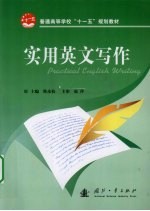

实用英文写作PDF电子书下载
- 电子书积分:10 积分如何计算积分?
- 作 者:韩彦枝编著
- 出 版 社:北京:国防工业出版社
- 出版年份:2010
- ISBN:9787118067941
- 页数:236 页
Chapter 1 Applying Words Properly 1
1.1 Types of words 1
1.1.1 Common words,technical words and nonstandard words 1
1.1.2 Formal words and colloquial words 1
1.1.3 Abstract words and concrete words 2
1.1.4 General words and specific words 3
1.2 Meanings of words 3
1.2.1 Polysemy 3
1.2.2 Denotation and connotation 3
1.2.3 Context and meaning 4
1.3 Synonyms 4
1.4 The use of words 6
1.4.1 Collocation 6
1.4.2 The usage of a word 7
1.4.3 Variety in using words 7
1.5 Idiom 9
1.6 Diction 10
1.7 Exercises 11
Chapter 2 Writing Correct and Effective Sentences 13
2.1 Types of sentences 13
2.1.1 Classified according to the elements 13
2.1.2 Classified according to function 14
2.1.3 Classified according to structure 14
2.1.4 Classified according to length 15
2.1.5 Classified according to rhetoric 16
2.1.6 Exercises 17
2.2 Effective sentences 18
2.2.1 Unity 18
2.2.2 Conciseness 19
2.2.3 Clarity 21
2.2.4 Coherence 22
2.2.5 Variety 23
2.2.6 Emphasis within sentences 25
2.2.7 Emphatic sentences 27
2.2.8 Exercises 29
2.3 Sentence skills 30
2.3.1 Complete sentences,minor sentences and sentence fragments 31
2.3.2 Coherence and incoherence 32
2.3.3 Fused sentences or run-on sentences 36
2.3.4 Comma splices and comma faults 36
2.4 Effective sentence patterns for English writing 37
2.5 Exercises 46
Chapter 3 Paragraph 48
3.1 Isolated paragraph 48
3.1.1 Controlling idea 48
3.1.2 Support of the controlling idea 49
3.2 Five-paragraph writing 50
3.2.1 Introductory paragraph 51
3.2.2 Topic sentence 52
3.2.3 Central paragraph 57
3.2.4 Concluding paragraph 58
3.2.5 Transitional words and phrases 60
3.2.6 Developing paragraph 61
3.2.7 Exercises 88
Chapter 4 Writing a Whole Essay 105
4.1 Steps in writing a whole essay 105
4.1.1 Planning 105
4.1.2 Drafting 108
4.1.3 Revision 109
4.1.4 Finalizing 110
4.2 Main parts of an essay 110
4.2.1 The opening part 110
4.2.2 The developing part 111
4.2.3 The closing part 111
4.3 Types of writing 111
4.3.1 Description 111
4.3.2 Narration 115
4.3.3 Argumentation 118
4.3.4 Exposition 120
4.4 Exercises 134
Chapter 5 Practical Writing 135
5.1 Letters 135
5.1.1 Introduction 135
5.1.2 Format of letters 136
5.1.3 Letters of introduction 141
5.1.4 Job application letters 142
5.1.5 Application for admittance 145
5.1.6 Exercises 148
5.2 Resume 148
5.2.1 Brief introduction 148
5.2.2 Content and organization 149
5.2.3 Sample writing 152
5.2.4 Exercises 154
5.3 Brief messages 154
5.3.1 Notes 154
5.3.2 Greeting cards 167
5.3.3 Notices 169
5.3.4 Fax messages 170
5.3.5 E-mails 172
5.3.6 Exercises 173
Chapter 6 CET Writing 175
6.1 Introduction of CET writing 175
6.1.1 Requirements 175
6.1.2 Principles of scoring 175
6.1.3 Standards of scoring 175
6.2 Analysis on types of writing 176
6.2.1 Topic sentence composition 176
6.2.2 Key words composition 177
6.2.3 Outline composition 178
6.2.4 Composition based on tables,graphs,charts,etc 180
Chapter 7 Writing a Research Paper 182
7.1 Steps in writing a research paper 182
7.1.1 Choosing a suitable topic 182
7.1.2 Collecting useful data for your paper 183
7.1.3 Analyzing materials and forming the outline 184
7.1.4 Drafting the paper 185
7.1.5 Revision and finalizing 186
7.2 The format of a research paper 187
7.2.1 The structure of a paper 187
7.2.2 Using quotations 187
7.2.3 The format for adding notes and the final bibliography 188
7.3 Exercises 192
Chapter 8 Using Rhetoric Appropriately 194
8.1 Lexical stylistic devices 194
8.1.1 Simile 194
8.1.2 Metaphor 195
8.1.3 Metonymy 195
8.1.4 Synecdoche 195
8.1.5 Personification 196
8.1.6 Hyperbole 196
8.1.7 Understatement 197
8.1.8 Transferred epithet 197
8.1.9 Euphemism 197
8.1.10 Pun 198
8.1.11 Irony 198
8.1.12 Paradox 198
8.1.13 Oxymoron 199
8.1.14 Allusion 199
8.2 Syntactical stylistic devices 200
8.2.1 Repetition 200
8.2.2 Climax 200
8.2.3 Anticlimax 201
8.2.4 Antithesis 201
8.2.5 Parallelism 202
8.2.6 Rhetorical question 203
8.2.7 Inversion 203
8.3 Phonetic stylistic devices 203
8.3.1 Alliteration 203
8.3.2 Assonance 204
8.3.3 Consonance 204
8.4 Exercises 205
Chapter 9 Punctuation and Manuscript Form 207
9.1 The functions of ordinary punctuation marks 207
9.1.1 Comma(,) 207
9.1.2 Period(.) 208
9.1.3 Question mark(?) 209
9.1.4 Exclamation mark(!) 209
9.1.5 Colon(:) 209
9.1.6 Semicolon(;) 210
9.1.7 Quotation marks(" ") 210
9.1.8 Parentheses(()) 211
9.1.9 Dash(—) 212
9.1.10 Ellipsis points(...) 212
9.2 Manuscript form 212
9.2.1 Pages 212
9.2.2 Title 212
9.2.3 Indention 213
9.2.4 Italics 213
9.2.5 Capitalization 213
9.3 Exercises 214
Appendix 216
Answers to exercises 219
References 236
- 《剑桥国际英语写作教程 段落写作》(美)吉尔·辛格尔顿(Jill Shingleton)编著 2019
- 《语文阅读与写作教学研究》李玉红,陈晓玲,王芬著 2018
- 《观察、阅读、写作小学作文整体教学与思维训练》马芯兰主编 2016
- 《剑桥国际英语写作教程 从句子到段落》(美)劳里·布拉斯(Laurie Blass),(美)德德拉·戈登(Deborah Gordon)编著 2019
- 《商务英语写作中批判性同伴反馈教学理论与实践》刘晓庆责任编辑;高现伟 2019
- 《新媒体行业写作与推广108招 打造专业内容,成就企业品牌》陈志红 2019
- 《如何指导博士生学术写作 给导师的教学法》(澳)芭芭拉·凯姆勒(Barbara Kamler),帕特·托马斯(Pat Thomson)著 2020
- 《高考英语自学丛书 概要写作》祝嘉 2018
- 《你只是看上去在陪孩子写作业》王莉著 2019
- 《剑桥国际英语写作教程 短文写作》(美)安·O.施特劳赫(Ann O. Strauch)编著 2019
- 《市政工程基础》杨岚编著 2009
- 《家畜百宝 猪、牛、羊、鸡的综合利用》山西省商业厅组织技术处编著 1959
- 《《道德经》200句》崇贤书院编著 2018
- 《高级英语阅读与听说教程》刘秀梅编著 2019
- 《计算机网络与通信基础》谢雨飞,田启川编著 2019
- 《看图自学吉他弹唱教程》陈飞编著 2019
- 《法语词汇认知联想记忆法》刘莲编著 2020
- 《培智学校义务教育实验教科书教师教学用书 生活适应 二年级 上》人民教育出版社,课程教材研究所,特殊教育课程教材研究中心编著 2019
- 《国家社科基金项目申报规范 技巧与案例 第3版 2020》文传浩,夏宇编著 2019
- 《流体力学》张扬军,彭杰,诸葛伟林编著 2019
- 《指向核心素养 北京十一学校名师教学设计 英语 七年级 上 配人教版》周志英总主编 2019
- 《北京生态环境保护》《北京环境保护丛书》编委会编著 2018
- 《指向核心素养 北京十一学校名师教学设计 英语 九年级 上 配人教版》周志英总主编 2019
- 《抗战三部曲 国防诗歌集》蒲风著 1937
- 《高等院校旅游专业系列教材 旅游企业岗位培训系列教材 新编北京导游英语》杨昆,鄢莉,谭明华 2019
- 《中国十大出版家》王震,贺越明著 1991
- 《近代民营出版机构的英语函授教育 以“商务、中华、开明”函授学校为个案 1915年-1946年版》丁伟 2017
- 《新工业时代 世界级工业家张毓强和他的“新石头记”》秦朔 2019
- 《智能制造高技能人才培养规划丛书 ABB工业机器人虚拟仿真教程》(中国)工控帮教研组 2019
- 《陶瓷工业节能减排技术丛书 陶瓷工业节能减排与污染综合治理》罗民华著 2017
